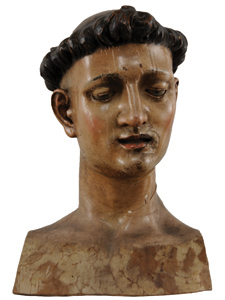Saint Anthony of Padua (Hall 25)

One of the most exceptional artists from the Spanish Baroque is Gregorio Fernández. He lived and worked almost exclusively in Valladolid, where he ran an active workshop with a great many collaborators. Though he died in 1636, his influence on Spanish sculpture continued throughout the 17th century and his models were repeated by his followers and collaborators.
This artist and his workshop have been credited with the following sculptural fragments: the head, the hands and feet, the figures of two children and a book. Thanks to an old photograph, we know that all of these fragments belonged to a dressed sculpture of Saint Anthony of Padua. The head is modeled in the naturalist style with strong features. Its gaze points down toward the Child he once held in his arms; the infant Jesus corresponds to the figure that extends its left arm. The other child was an angel that sat at his feet. He held a book in his left hand that featured a text from the liturgy corresponding to the saint's feast day. The three faces have glass eyes and pronounced locks of hair. Hands and feet rounded out the main figure. Gregorio Fernández also sculpted another dressed Saint Anthony-the one he made for the Church of San Miguel in Valladolid. That statue stands apart from the one seen here, as the artist also sculpted the saint's naked body.
Fernández is especially notable for the realism found in his figures and the modeled naturalism in their faces, making them seem like real living beings. But the most incredible aspect is the spirituality and inner life they transmit. The artist created several types of figures that were frequently requested by clients. He also made processional sculptures.
This piece, whose origins are not known, was private property for many years. It was used for devotional purposes until it was donated to the museum.


